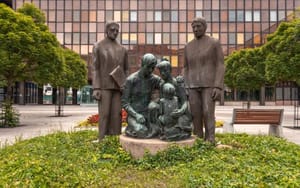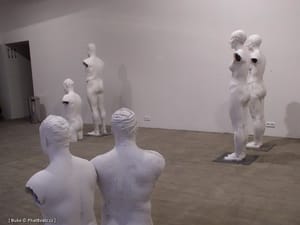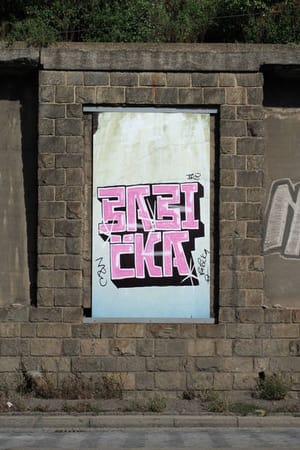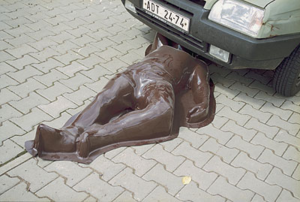- Members included in database
- Other members (not included in database)
-
Lucie Krejčová
Martin Péč
Marek Rejent
- Founded
- 2001
- Keywords
About group
Matky a otcové (Mothers and Fathers) is a an artistic-social group formed by Lenka Klodová (born 1969), Lucie Krejčová (born Nepasická, 1969), Martin Péč (born 1967) and Marek Rejent (born 1969). In their work, they focus on the issues of parenting and child care. They draw on shared personal experiences and family situations, on everyday troubles and worries, which they try to reconcile with their artistic work and creatively process. In the intimate family topics, they discover common mechanisms, recurring stereotypes, questions that they strive to pose not only on a personal but also on a social level. Their work is informed by the knowledge that we all deal with similar domestic issues, deliberately combining an ironic and critical perspective with empathy and understanding.
The four artists of the Matky a otcové group belong to the generation of artists who met in the 1990s at the Academy of Arts, Architecture and Design in the Sculpture Studio led by Kurt Gebauer. The only exception is Lucie Krejčová, who at that time studied Metal and Jewellery at the same school. At the turn of the millennium, the future members of the group got married, started families and also dealt with the changes related to graduation. They struggled with the challenges of starting out on the art scene, facing difficult social realities and financial hardships. In 1999, several former classmates, including Lenka Klodová, Martin Pécs and Marek Rejent, went to Brussels, where they initiated spontaneous interventions in the public space. After their return, an exhibition was held in Prague to present these activities.
In 2001, the artists – already as a complete team – presented their work at the NoD gallery, and although this exhibition was more in the nature of a presentation of four individual personalities, it was on this occasion that their first joint project, Matky a otcové band, was introduced. In the following year, Matky a otcové officially took on a collective artistic identity producing their own work and programme. They held an exhibition called Matky a otcové nabízejí at the Academy of Arts, Architecture and Design in Prague that was topped off with the sale of all artistic works from the exhibition. The individual works were presented under the common name Matky a otcové without individual authorship and represented objects with family and domestic themes. The group dealt with everyday situations and experiences, partner and parental relationships in a straightforward, honest and pathos-free way. In the works such as Polštáře (2002), Otec – dekorativní předmět (2002) and Staré panenky (2002), the artists underlined this approach by using commonly available materials and exhibited ready-made objects found in almost every household. Most of these were things we would rather not see, not admit to, or omit, such as worn bras, dirty dishes, or used dishwashing sponges. Matky a otcové declared that they wanted to present the concentrated essence of their parental experience, which, albeit exclusively personal, is also universally valid. Starting with the very first exhibition of these artists, the name of the group refers not only to their social and societal situation, but also reveals the main source of their inspiration: everyday events related to raising children and taking care of the household.
The name Matky a otcové contains several levels of meaning. It points to the fact that all members of the group are parents. At the same time, however, it also emphasizes their gender identity, suggesting that the gender dynamics and social roles attributed to mothers and fathers are an important starting point in their artistic and personal reflection. Matky a otcové emerged from experience sharing as well as mutual support in parental trouble and during their difficult start of an artistic career. In a sense, this group thus also serves as a supportive association in which collective artistic creation is perceived, among other things, as a therapeutic tool. Working together helps them create a space to analyse phenomena that lie at the intersection of two identities highlighted in this context – what is it like to be both an artist and a mother, an artist and a father?
Matky a otcové expressed their view on the issues in 2007 in the form of an exhibition called Co bychom byli bez dětí. The installation consisted of 4 pairs of plaster castings, with one version of the casting always being more realistic and the other expressing a sleek, more ideal form of each of the group’s members. The sculptures were arranged in the gallery space in pairs to represent two possible identities, two levels between which the members of the group move. At the same time, the physical form of the sculptures on display and their processing reflects an important element of their creation, which is thinking and commenting on a certain problem by means of the material. Matky a otcové subtly shift the meaning of objects through changes of their context, function or way of processing. The resulting works thus fall into an ambivalent position and this ambiguity encourages a different, more nuanced view of the subject.
In a similar way, the group also worked on the project Family Art Crimes from 2006, for which inscriptions were created as graffiti in the public space offered by Artwall Gallery. In this case, the artists appropriated for themselves a favourite means of expression of the young generation and in this way reflected on their relationships with their children. The work with language is key in this case, the words rendered in the form of graffiti are associated with family life (“daddy”, “grandma”) and they embody the process of trying to find common language between two generations. In this way, the group also challenges the widespread stereotype of the criminal character of graffiti art.
In 2020, Matky a otcové also made a contribution to the group exhibition O čem mluvíme, když mluvíme o rodině including an intervention in the public space. A popular subject of public sculpture commissions, the genre of the family, came to the centre of their interest. The type of the created sculpture, however, almost exclusively depicted the traditional nuclear family consisting of a mother, a father and a child, which in this form was supposed to represent a model of stability and harmony. The members of the group chose one particular work, a sculpture by Ivan Záleský in Ústí nad Labem, which they complemented with two other figures: those of lawyers. In contrast to the originally round shapes and lyrical atmosphere, the group presented two stiff, massive sculptures, while using textiles and plaster in contrast to the original stone material. The purpose of this intervention was to give the sculpture a realistic dimension and to respond to the current problems that many families are facing.
At the outset of the twenty-first century, Matky a otcové was one of the first artistic groups in the Czech Republic to focus programmatically on the issue of parenthood and the position of artists-parents in the artistic infrastructure. The group’s contribution was also in their approach to this topic in a gender-balanced way. By means of a dialogue between its members, they actively explored the gender dynamics, similarities and differences that mothers and fathers face in the family or in the arts. Since the early days of Matky a otcové, other artistic initiatives such as Kojící guerilla or Mothers Artlovers have emerged on the Czech scene whose activities have included not only artistic or support activities, but also activism.
- Author of the annotation
- Viktória Beličáková
- Published
- 2021
Exhibitions
- Other exhibitions/events
Samostatné výstavy (výběr): 2007
Co bychom byli bez dětí, Galerie c2c 2006
Family Art Crimes, Galerie Artwall 2002
M&O množstevní sleva, Galerie Klatovy-Klenová
Matky a otcové nabízejí, Galerie Jednička, Vysoká škola uměleckoprůmyslová Skupinové výstavy: 2020
O čem mluvíme, když mluvíme o rodině, kurátorka Maro Hajrapetjan, Dům umění Ústí nad Labem 2017
To je mámovo!, kurátorka Kateřina Olivová, White Room, Pragovka 2009
Formáty transformace 89-09, Dům umění města Brna
Monography, catalogues, publications
- Monography, catalogues, publications
KUTIS, Barbara. Artist-Parents in Contemporary Art: Gender, Identity, and Domesticity. Vyd. 1. New York: Routledge, 2020.
- Articles, media, internet
Radek WOHLMUTH: Rodinná pouta – Matky a Otcové, s.r.o., Umělec 2005/1 http://divus.cc/praha/cs/article/family-bonds-mothers-and-fathers-ltd?printLayout=true Matky a Otcové: Na holou!, Fotograf: časopis pro fotografii a vizuální kulturu, roč. 8, č. 13, 2009



